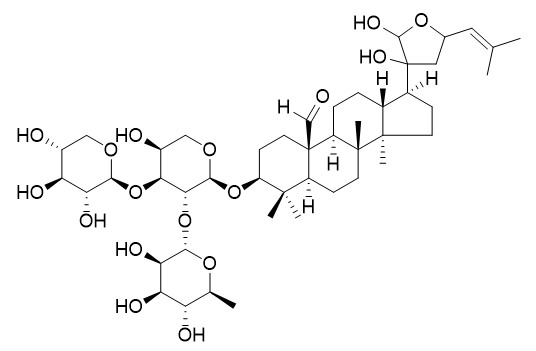Gypenoside A
Reference standards.
Inquire / Order:
manager@chemfaces.com
Technical Inquiries:
service@chemfaces.com
Tel:
+86-27-84237783
Fax:
+86-27-84254680
Address:
1 Building, No. 83, CheCheng Rd., Wuhan Economic and Technological Development Zone, Wuhan, Hubei 430056, PRC
Providing storage is as stated on the product vial and the vial is kept tightly sealed, the product can be stored for up to
24 months(2-8C).
Wherever possible, you should prepare and use solutions on the same day. However, if you need to make up stock solutions in advance, we recommend that you store the solution as aliquots in tightly sealed vials at -20C. Generally, these will be useable for up to two weeks. Before use, and prior to opening the vial we recommend that you allow your product to equilibrate to room temperature for at least 1 hour.
Need more advice on solubility, usage and handling? Please email to: service@chemfaces.com
The packaging of the product may have turned upside down during transportation, resulting in the natural compounds adhering to the neck or cap of the vial. take the vial out of its packaging and gently shake to let the compounds fall to the bottom of the vial. for liquid products, centrifuge at 200-500 RPM to gather the liquid at the bottom of the vial. try to avoid loss or contamination during handling.
Industrial Food Engineering2015, 19(4):408-413
Int J Mol Sci.2024, 25(2):764.
Phytomedicine.2022, 100:154058.
Res Rep Urol.2022, 14:313-326.
Food Science and Biotechnology2015, 2205-2212
Int J Oncol.2019, 55(1):320-330
Phytochemistry Letters2021, 43:80-87.
J Agric Food Chem.2016, 64(35):6783-90
Green Chem.2023, 25:5222-5232
Front Endocrinol (Lausanne).2020, 11:568436.
Related and Featured Products
Zhong Yao Cai. 1997 Aug;20(8):398-400.
Determination on the glycosyl sequence of gypenoside A by TLC-FABMS.[Pubmed:
12572416]
METHODS AND RESULTS:
The glycosyl sequence of Gypenoside A (A) isolated from Gynostemma pentaphyllum Makino was determinated by TLC-FABMS. The Gypenoside A was hydrolysed with cellulase and the hydrolysate showed eight spots on a TLC plate, and the FABMS analysis of these spots indicated they corresponded to Gypenoside A, A-Rham, A-Glu, A-Rham-Glu, A-Rham-Glu, A-Glu-Glu, A-Rham-2Glu, A-Rham-2Glu in order.
Two chains can be determined to be Rham-Glu, and Glu-Glu, respectively.
CONCLUSIONS:
So the glycosyl sequence of Gypenoside A was identical of gypenoside XLIII.



